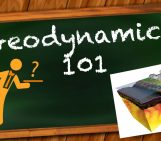
Every week, The Sassy Scientist answers a question on geodynamics, related topics, academic life, the universe or anything in between with a healthy dose of sarcasm. Do you have a question for The Sassy Scientist? Submit your question here or leave a comment below.
In a comment on a post about the key papers in geodynamics, the Curmudgeonly Commenter asked:
Could you please point out some exceptionally important papers in geodynamics and tell us something interesting about the history of the field?
Dear CC,
As explained in last week’s post, we will start from the very beginning: a time and place where everything was still considered elastic.
Elastic rebound theory
After millennia of attributing earthquakes to gods and mythical beasts (what a wondrous time that must’ve been), and a plethora of decades since the design of the first western seismographs, with a poor understanding of the source mechanism behind an earthquake, H.F. Reid (1910) proposed a theory on the occasion of the great 1906 San Francisco earthquake. The elastic rebound theory states that elastically stored energy is released suddenly during an earthquake on a pre-existing fault plane that resides in the solid crust. There is no need to generate a new fracture interface. Benioff (1949, 1954, 1964) — yes, the one comprising half of the name of the Wadati-Benioff zone — championed this theory and concluded that at least the shallow and intermediate-depth earthquakes could be attributed to this mechanism. Benioff considered deeper earthquakes (>300 km), posing less of a seismic hazard at the surface, to result from volumetric changes; no fracturing nor fault slip on a plane. A further refinement of the elastic rebound theory was necessary though in order to explain e.g., the low-magnitude stress changes that arise in the lithospheric medium as a result of earthquake ruptures.
Elastic dislocation theory
Whereas the nucleation of earthquakes was one line of inquiry, another was to use actual surface observations to infer fault slip at depth. There’s nothing better than guessing from afar what’s actually happening below the surface, right? Building on Volterra’s (1907) theory of distortions in elastic bodies — you know, by atomic off-sets in crystal structure — Steketee (1958) and Chinnery (1961) provided elementary steps forward in determining the surface deformation that result from motion on dislocations that reach the surface. Later, Savage and Burford (1970, 1973) and Okada (1985, 1992) elaborated and expanded elastic dislocation theory to include a complete set of analytical expressions of (surface) deformation due to slip on a (buried) fault (segment) in an elastic half-space. To this day still, these simple analytical expressions are widely used, both for fault slip inversions (e.g., Bagnardi and Hooper 2018), and elastic block models (e.g., Meade and Loveless 2009). In the elastic realm of the lithosphere, static stress changes are transferred and may trigger new earthquakes on other faults (King 1994; Stein 1999). This is already getting dangerously close to actual dynamics, instead of only finding descriptions of surface kinematics. What a waste …
Unfortunately, that’s all we have time for this week. Next week, I promise we will finally get into a bit more of the dynamics. Let’s discuss the earthquake cycle for instance.
Yours truly,
The Sassy Scientist
PS: This post was written with all things elastic in my mind. Is your mind as flexural as mine?
References: Bagnardi, M. and Hooper, A. (2018), Inversion of surface deformation data for rapid estimates of source parameters and uncertainties: A Bayesian approach. Geochemistry, Geophysics, Geosystems, 19, 2194–2211. https://doi.org/10.1029/2018GC007585 Benioff, V.H. (1949), Seismic evidence for the fault origin of oceanic deeps. Bulletin of the Geological Society of America, 60, 1837-56 Benioff, V.H. (1954), Orogenesis and deep crustal structure—additional evidence from seismology. Bulletin of the Geological Society of America, 65, 385-400 Benioff, V.H. (1964), Earthquake source mechanisms. Science, 143, 1399-1406 Chinnery, M.A. (1961), The deformation of ground around surface faults. Bulletin of the Seismological Society of America, 51, 355-372 King, G.C., Stein, R. and Lin, J. (1994). Static stress changes and the triggering of earthquakes. Bulletin of the Seismological Society of America, 84(3), 935–953 Meade, B.J. and Loveless, J.P. (2009), Block modeling with connected fault network geometries and a linear elastic coupling estimator in spherical coordinates. Bulletin of the Seismological Society of America, 99(6), 3124–3139 Okada, Y. (1985), Surface deformation due to shear and tensile faults in a half-space. Bulletin of the Seismological Society of America, 75, 1135-1154 Okada, Y. (1992), Internal deformation due to shear and tensile faults in a half-space. Bulletin of the Seismological Society of America, 82(2), 1018–1040 Reid, H.F. (1910), The California Earthquake of April 18, 1906. Volume II. The Mechanics of the Earthquake. Washington DC: Carnegie Institution of Washington, Publication No. 87 Savage, J.C. and Burford, R.O. (1970), Accumulation of tectonic strain in California. Bulletin of the Seismological Society of America, 60, 1877–1896 Savage, J.C. and Burford, R.O. (1973), Geodetic determination of relative plate motion in central California. Journal of Geophysical Research, 78, 5, 832–845 Stein, R.S. (1999), The role of stress transfer in earthquake occurrence. Nature, 402, 605–609 Steketee, J.A. (1958), On Volterra's dislocation in a semi-infinite elastic medium. Canadian Journal of Physics, 36, 192-205 Volterra, V. (1907), Sur l'équilibre des corps élastiques multiplement connexes. Annales scientifiques de l'École Normale Supérieure, 24, 401-517




The Curmudgeonly Commenter
Great stuff, especially the link to the 109-year-old paper in the references. Hartelijk dank!
amel fs
Thanks for sharing this great article
The Sassy Scientist
You know, there are some other articles in this series you might find interesting too.
Like this one.
Or this peach.
Maybe even this gem.
I just found another classic.
And let’s not forget about the final pinnacle.
brahim d staps
Nice post thanks
tassnime
Thank you ever so for you article.
savingchief
Thanks for this amazing post.
tita
Great, thanks for sharing this blog post.
saber
Will is what pushes you to the first step on the path of struggle, but determination is what keeps you on this path until the end. Every step forward is a step towards achieving something bigger and better than what you are currently. thank you